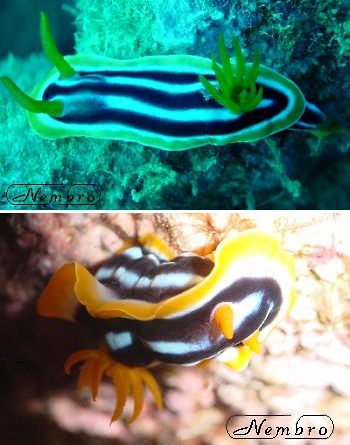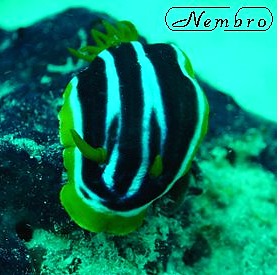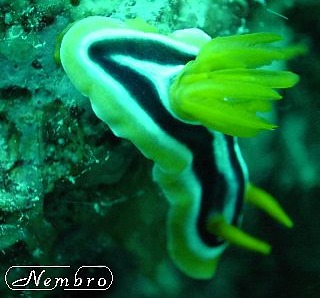Chromodoris quadricolor? from the Red Sea
April 27, 2002
From: Marina Poddubetskaia

Dear Bill,
Here are some chromodorids I photographed at the end of March when I spent a week in Egypt. It was a dive cruise at the North of Red Sea, between Hurghada and Sinai mountains.
I have left the most interesting, which I have identified as Chromodoris quadricolor, until the end. It was present at all sites, between 2 and 22m. Local books call it Ch. quadricolor or Chromodoris pyjama(?!). But it also looks like Ch. africana or Ch. magnifica. I don't see the difference between these 3 species. Could you let me know what they are?
The most common form has 2 regular white/blue middle bands. Sorry, but I didn't note that I didn't take enough photos of this form (any with back view). But there are other forms (or species ?). I think there is a transformation : it begins with the partition of middle bands from 2 to 4. In local books I saw the photos of these guys in which the top (near rhinophores) of 3rd band joins the bottom (near gills) of 2nd band. The final step of this transformation is the photo you have identified as C. strigata.
Thank you for your help.
Best wishes,
Marina.
marina.poddubetskaia@francetelecom.com



Dear Marina,
I think we still have a few things to sort out with the black-lined chromodorids of the Red Sea region. The most important thing to realise is that in certain parts of the world some of the local chromodorids have evolved to mimic the colour patterns of each other. See the page on mimicry on chromodorids. Outside the Red Sea, the distinction between Chromodoris quadricolor and Chromodoris africana is quite clear. C. quadricolor is quite elongate with a relatively narrow mantle skirt down each side, while C. africana has a softer body, and the wide mantle skirt is much thinner in thickness (ie: much less rigid to the touch). In colour they are quite different, C. quadricolor, as it name suggests has four 'colours', [black, white, blue, orange] not the three [black, white, orange] of C. africana. In 'typical' C. quadricolor there is only a very thin line separating the orange border from the outermost black bands. I have included alongside a copy of the original painting of C. quadricolor (Rüppell & Leuckart, Pl.9, fig. 2).
Most photos I have seen from the Red Sea suggest that in that region the white line between the outer black band and the orange border is not as narrow as in specimens from East Africa, or as wide as in C. africana. It also seems that the blue background colour in the central region can sometimes be absent. The Indo-West Pacific species, C. magnifica differs in having a submarginal rather than marginal orange border. The splitting of the black bands into thinner secondary bands appears to occur in a number of species.
So how can we be sure which is which? I have described radular differences, but that is not a practical way to identify them in the field. I think we need to know more about their biology. Do they all eat the bright orange red sponge they are often photographed on?, what are their egg ribbons like? etc. The only study of a large population was Gohar & Abul-Ela's (1959) who studied 'several hundred specimens'. Unfortunately I am not sure if they were studying C. quadricolor or C. africana as they describe then as having bluish-black and white bands, which suggests C. africana. Whatever species they had it is interesting that they note that the egg ribbon was flat as reported for many of the C. quadricolor colour-group in the western Pacific.
Some of Marina's photos have blue in the central region, some do not. There is of course another possibility, and that is that this common animal often photographed on the red sponge is a third unnamed species mimicking both C. africana and C. africana. Which only brings me back to the need for more information on their food. Has anyone got photos of what I consider 'typical' C. quadricolor and C. africana on sponge? It would be nice to get some indication that they eat something different.
Concerning 'Chromodoris pyjama' - I think this is an invented name.
References:
• Gohar, H.A.F. & Aboul-Ela, I.A. (1959) On the biology and development of three nudibranchs (from the Red Sea). Publications of the Marine Biological Station, Al-Ghardaqa, Egypt, 10: 41-62. (Pls.1-5)
• Rüppell, E. & Leuckart, F.S. (1830 or 31) Neue wirbellose Thiere des Rothen Meeres. Atlas zu der Reise im nördlichen Afrika von Eduard Rüppell. Brunner, Frankfurt am Main. 23-50, pls 7-12 pages.
Sorry I can't give you a definitive answer but perhaps it will encourage visitors to the Red Sea to try and find blue-banded and white-banded 'C. quadricolor' together on the photogenic Red Sponge or even better 'C. quadricolor', of any colour, on a sponge other than the famous red one.
Best wishes,
Bill Rudman
Related messages
-
Re: Abnormalities in Chromodoris quadricolor
From: Joe De Vroe, May 7, 2009 -
Chromodoris quadricolor & black sponge
From: Kamal El Tawil, July 2, 2008 -
Another Chromodoris africana from Tofo, Mozambique
From: Natasja Vandeperre, April 28, 2008 -
Re: Chromodoris quadricolor and the cowrie
From: Vittorio Bruzzone, December 4, 2007 -
Chromodoris quadricolor and egg ribbon
From: Vittorio Bruzzone, December 4, 2007 -
Chromodoris quadricolor and the cowrie
From: Vittorio Bruzzone, November 27, 2007 -
Chromodoris quadricolor feeding?
From: Eddy Mannak, October 4, 2007 -
Abnormalities in Chromodoris quadricolor
From: Eddy Mannak, August 6, 2007 -
Chromodoris quadricolor feeding on black sponge ?
From: Kamal El Tawil, July 17, 2007 -
Chromodoris quadricolor from the Red Sea
From: Clarke Duncan, April 19, 2006 -
Chromodoris quadricolor from the Red Sea
From: Clarke Duncan, April 19, 2006 -
Chromodoris quadricolor - behaviour
From: Binyamin Koretz, March 1, 2006 -
Chromodoris africana or C.quadricolor
From: Umut Tural, February 10, 2006 -
Chromodoris quadricolor from Egyptian Red Sea
From: Chris Dekker, November 30, 2005 -
Re: Is this also Chromodoris quadricolor?
From: Binyamin Koretz, November 5, 2005 -
Is this also Chromodoris quadricolor?
From: Jacob Dafni, October 25, 2005 -
Chromodoris quadricolor - strange behaviour
From: Kamal El Tawil, October 7, 2005 -
Chromodoris quadricolor from Egyptian Red Sea
From: Kamal el Tawil, June 6, 2005 -
Chromodoris quadricolor from Egypt
From: Matan Ninio, March 25, 2005 -
Chromodoris quadricolor from the Red Sea
From: Binyamin Koretz, March 16, 2005 -
'Pyjama slugs' from the Red Sea
From: Ilan Ben Tov, May 21, 2003 -
Chromodoris quadricolor or C. magnifica
From: Marina Poddubetskaia, March 10, 2003 -
Chromodoris quadricolor or C. magnifica (2)
From: Marina Poddubetskaia, March 10, 2003 -
Chromodoris quadricolor/africana from Jordan
From: Erwin Koehler, December 14, 2002 -
Chromodoris quadricolor from Jordan
From: Erwin Koehler, December 10, 2002 -
Chromodoris quadricolor from Egypt
From: Michael Mrutzek, October 1, 2002 -
Chromodoris quadricolor from Saudia Arabia
From: Larry Dupriest, April 2, 2001 -
Chromodoris quadricolor? from the Red Sea
From: Erwin Koehler, January 8, 2001 -
Chromodoris africana from Red Sea
From: Jochen Scholtyssek, July 7, 2000
